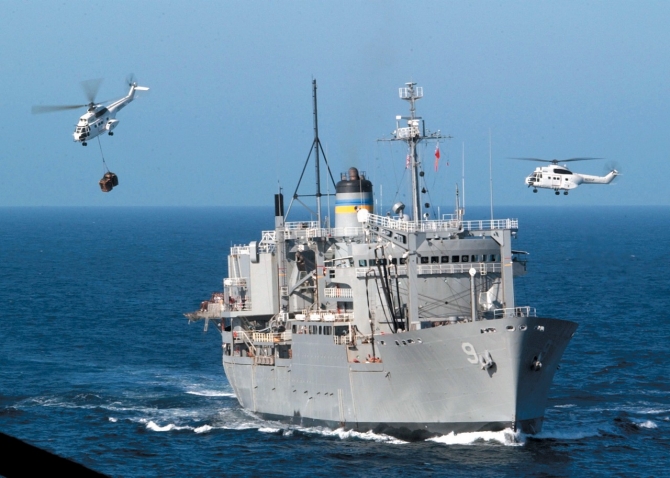Spica II (AFS-9)
1981–2008
A star of the first magnitude in the constellation Virgo. The first ship named Spica (AK-16) served from 1940 to 1946.
II
(AFS-9: displacement 16,680; length 523'; beam 72'; draft 26'; speed 20+ knots; complement 193; aircraft 2 Boeing-Vertol UH-46 Sea Knights; class Sirius)
The second Spica (AFS-9) was laid down as British Ness-class fleet stores ship Tarbatness (A.345) on 1 April 1965 at Wallsend-On-Tyne, United Kingdom, by Swan Hunter & Wigham Richardson, Ltd.; launched on 1 February 1967; placed in service with the Royal Fleet Auxiliary on 1 August 1967; and sold to the U.S. Military Sealift Command (MSC), which placed her in service at Pier 2, Naval Supply Center, Norfolk, Va., on 5 November 1981.

A chartered Aérospatiale SA.330J Puma flying from Spica crashed while vertically replenishing aircraft carrier Harry S. Truman (CVN-75) in the eastern Mediterranean, during Operation Iraqi Freedom I, on 7 April 2003. The moon had just set, reducing the visibility, and fuel and debris in the water further complicated the rescue. A Sikorsky HH-60H Seahawk, manned by pilot Lt. Jack McKechnie, aircraft commander Lt. Dustin Smiley, and Aviation Antisubmarine Warfare Operators 1st Class Greg Baker and 3rd Class Jason Boutwell of Antisubmarine Helicopter Squadron (HS) 3, flew plane guard from Theodore Roosevelt (CVN-71). “We saw strobe lights [part of the pilot’s survival equipment] in the water,” McKechnie recalled. “We slowed down, hovered over the lights and opened the cabin door to get a better look. That’s when we saw the two survivors.” The Seahawk lowered Boutwell into the water, and he assisted one of the men into the safety harness and they hoisted him aloft. A second Seahawk from HS-7 meanwhile flew from Harry S. Truman, and lowered Aviation Antisubmarine Warfare Operator 1st Class Jeremy Burkart. “As soon as I got into the water, I was lowered into an oil slick,” Burkart explained. “I was covered in jet fuel from the helo and I couldn’t see anything through my mask.” The rescue swimmer persevered through the cold, oil-choked water, and saved the second survivor.
The Integrated Bridge System on board Monterey (CG-61) suffered a casualty while the guided missile cruiser replenished from Spica in the Arabian Gulf on 17 March 2005. The ships collided and sustained minor damage, but neither vessel reported injuries to crewmembers.
Spica was stricken on 25 January 2008, and laid up at the Naval Sea Systems Inactive Ships Maintenance Facility, Philadelphia, Pa. She was sunk as a target during an exercise off the U.S. East Coast on 6 May 2009.
Detailed history under construction.
Mark L. Evans
19 May 2014


